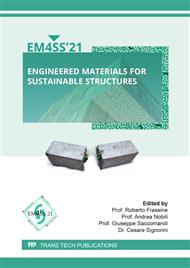[1]
P. J. Monteiro, S. A. Miller, A. Horvath, Towards sustainable concrete, Nat. Mater., 16 (2017) 698-699.
Google Scholar
[2]
D. Cuthbertson, U. Berardi, C. Briens, F. Berruti, F, Biochar from residual biomass as a concrete filler for improved thermal and acoustic properties, Biomass Bioenerg., 120 (2019) 77–83.
DOI: 10.1016/j.biombioe.2018.11.007
Google Scholar
[3]
S. Gupta, P. Krishnan, A. Kashani, H.W. Kua, Application of biochar from coconut and wood waste to reduce shrinkage and improve physical properties of silica fume-cement mortar, Constr. Build. Mater., 262 (2020) 120688.
DOI: 10.1016/j.conbuildmat.2020.120688
Google Scholar
[4]
S. Gupta, H.W. Kua, S. Dai Pang, Biochar-mortar composite: Manufacturing, evaluation of physical properties and economic viability, Constr. Build. Mater., 167 (2018), 874-889.
DOI: 10.1016/j.conbuildmat.2018.06.106
Google Scholar
[5]
M. R. Ahmad, B. Chen, H. Duan, Improvement effect of pyrolyzed agro-food biochar on the properties of magnesium phosphate cement, Sci. Total Environ., 718 (2020) 137422.
DOI: 10.1016/j.scitotenv.2020.137422
Google Scholar
[6]
S. Gupta, H.W. Kua, C. Y. Low, Use of biochar as carbon sequestering additive in cement mortar. Cem. Concr. Compos., 87 (2018) 110-129.
DOI: 10.1016/j.cemconcomp.2017.12.009
Google Scholar
[7]
A. Sirico, P. Bernardi, B. Belletti, A. Malcevschi, E. Dalcanale, I. Domenichelli, P. Fornoni, E. Moretti. Mechanical characterization of cement-based materials containing biochar from gasification, Constr. Build. Mater., 246 (2020) 118490.
DOI: 10.1016/j.conbuildmat.2020.118490
Google Scholar
[8]
N. Saikia, N., J. De Brito. Use of plastic waste as aggregate in cement mortar and concrete preparation: A review. Constr. Build. Mater., 34 (2012) 385–401.
DOI: 10.1016/j.conbuildmat.2012.02.066
Google Scholar
[9]
L. Gu, T. Ozbakkaloglu. Use of recycled plastics in concrete: A critical review. Waste Management, 51 (2016) 19–42.
DOI: 10.1016/j.wasman.2016.03.005
Google Scholar
[10]
R. Novotny, J. Sal, M. Ctibor, Environmental use of waste materials as admixtures in concrete, 2019 IOP Conf. Ser.: Mater. Sci. Eng. 603 052101.
DOI: 10.1088/1757-899x/603/5/052101
Google Scholar
[11]
A.J. Babafemi, B. Šavija, S.C. Paul, V. Anggraini, Engineering Properties of Concrete with Waste Recycled Plastic: A Review, Sustainability 2018, 10, 3875.
DOI: 10.3390/su10113875
Google Scholar
[12]
B. Coppola, L. Courard, F. Michel, L. Incarnato, P. Scarfato, L. Di Maio, Hygro-thermal and durability properties of a lightweight mortar made with foamed plastic waste aggregates, Constr. Build. Mater. 170 (2018) 200-206.
DOI: 10.1016/j.conbuildmat.2018.03.083
Google Scholar
[13]
S. Gupta, H. Wei Kua, Effect of water entrainment by pre-soaked biochar particles on strength and permeability of cement mortar, Constr. Build. Mater., 159 (2018) 107–25.
DOI: 10.1016/j.conbuildmat.2018.08.075
Google Scholar
[14]
A. Sirico, P. Bernardi, C. Sciancalepore, F. Vecchi, A. Malcevschi, B. Belletti, D. Milanese. Biochar from wood waste as additive for structural concrete, Constr. Build. Mater. 303 (2021), 124500.
DOI: 10.1016/j.conbuildmat.2021.124500
Google Scholar
[15]
EN 206:2013+A2:2021. Concrete - Specification, performance, production and conformity.
Google Scholar
[16]
EN 12390-3:2019. Testing hardened concrete - Part 3: Compressive strength of test specimens.
Google Scholar
[17]
UNI EN 12390-7:2019. Testing hardened concrete - Part 7: Density of hardened concrete.
Google Scholar
[18]
ASTM C114, Standard Test Methods for Chemical Analysis of Hydraulic Cement. (2011).
Google Scholar
[19]
ASTM C1218 / C1218M – 20, Standard Test Method for Water-Soluble Chloride in Mortar and Concrete. (2020).
Google Scholar
[20]
C. Andrade, M. Keddam, X.R. Nόvoa, M.C. Pérez, C.M. Rangel, H. Takenouti, Electrochemical behaviour of steel rebars in concrete: influence of environmental factors and cement chemistry, Electrochim. Acta 46 (2001) 3905– 3912.
DOI: 10.1016/s0013-4686(01)00678-8
Google Scholar
[21]
F. Zanotto, A. Sirico, F. Vecchi, A. Balbo, P. Bernardi, B. Belletti, A. Macevschi, V. Grassi, S. Merchiori, C. Monticelli, Durability of reinforced concrete containing biochar, In: Proceedings of the fib CACRCS DAYS 2020, on-line event (2020), 65-72.
DOI: 10.4028/p-mwn300
Google Scholar
[22]
P. Gu, S. Elliot, J.J. Beaudoin, B. Arsenault, Corrosion resistance of stainless steel in chloride contaminated concrete, Cem. Concr. Res. 26 (1996) 1151–1156.
DOI: 10.1016/0008-8846(96)00110-x
Google Scholar
[23]
K. Videm, Phenomena disturbing electrochemical corrosion rate measurements for steel in alkaline environments, Electrochimica Acta 46 (2001) 3895– 3903.
DOI: 10.1016/s0013-4686(01)00677-6
Google Scholar
[24]
A. Cotto-Ramos, S. Davila, W. Torres-Garcia, A. Caceres-Fernandez, Experimental design of concrete mixtures using recycled plastic, fly ash and silica nanoparticles, Constr. Build. Mater. 254 (2020) 119207.
DOI: 10.1016/j.conbuildmat.2020.119207
Google Scholar
[25]
U.M. Angst, M.R. Geiker, A. Michel, C. Gehlen, H. Wong, O.B. Isgor, B. Elsener, C.M. Hansson, R. François, K. Hornbostel, R. Polder, M. Cruz Alonso, M. Sanchez, M.J. Correia, M. Criado, A. Sagüés, N. Buenfeld, The steel–concrete interface, Mater. Struct. 50 (2017) 143.
DOI: 10.1617/s11527-017-1010-1
Google Scholar
[26]
U.M. Angst, M.R. Geiker, M. Cruz Alonso, R. Polder, O.B. Isgor, B. Elsener, H. Wong, A. Michel, K. Hornbostel, C. Gehlen, R. François, M. Sanchez, M. Criado, H. Sørensen, C. Hansson, R. Pillai, S. Mundra, J. Gulikers, M. Raupach, J. Pacheco, A. Sagüés, The effect of the steel–concrete interface on chloride-induced corrosion initiation in concrete: a critical review by RILEM TC 262-SCI, Mater. Struct. 52 (2019) 88.
DOI: 10.1617/s11527-019-1387-0
Google Scholar


